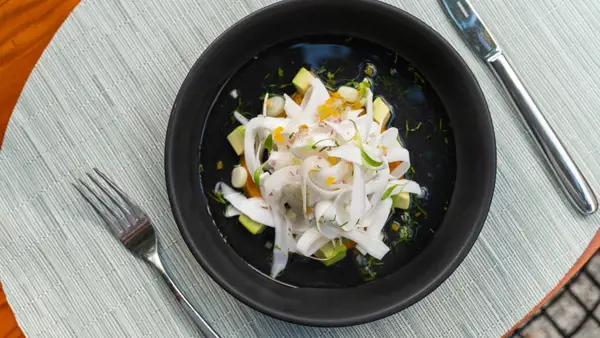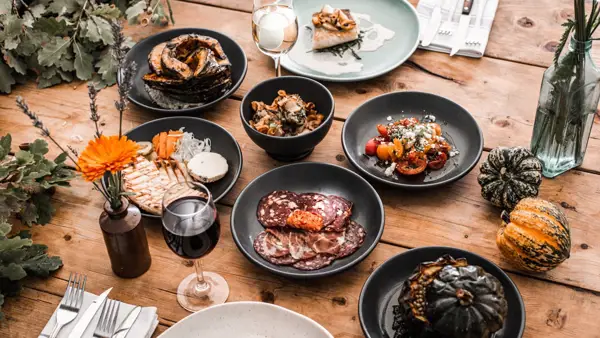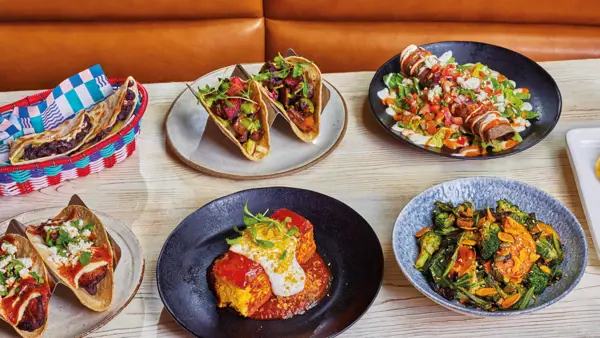Real Ways Restaurants are Dishing Up More Plants and Better Meat
24 September 2024
Share this exclusive content from Saladplate

Photo Credit: The Sustainable Restaurant Association (TSRA)
CONTINUING THIS MONTH’S FOCUS ON SERVING MORE PLANTS AND BETTER MEAT, THIS ARTICLE EXPLORES REAL-LIFE EXAMPLES FROM OF THE RESTAURANTS IN OUR NETWORK. READ ON TO LEARN WHY THEY MAKE THIS A PRIORITY AND TO DISCOVER THEIR BEST ADVICE FOR MAKING THIS WORK IN YOUR BUSINESS.
We asked some of the restaurants in our global network to share why they feel strongly about serving more plant-rich dishes and better-quality meat and how they set their menus up for success.
Why SHOULD RESTAURANTS adopt a ‘more plants, better meat’ strategy?
1. Feeding People Well
At Pythouse Kitchen Garden, the menu has been plant-rich from day one. “Our mission to use as much from the garden as we can makes this a natural path for us,” says Chef Darren Broom. “We serve balanced portions of responsibly sourced proteins to accompany, but the focus is very much on what we take inspiration from within the four walls of the kitchen garden.”
Broom points to human health as one big reason. “I believe a plant-rich diet – with high quality dairy, eggs and better meat in its most unrefined form – is our optimal diet,” he says, noting that a large number of plants in our diet is necessary for the diversity of our gut microbiomes. Broom advocates for animal-based protein to become a smaller part of our diets – and for that meat to be of the highest quality. “Protein-rich, nutrient-dense, well-sourced meat is something to be prized and treasured, savoured and enjoyed,” he says. “Better meat is the only meat that we chefs should be serving. It’s a necessity.”

At Limaná restaurant in Lima, Peru, the mission from the get-go has been to centre the menu on plant-based dishes and fish. The reasoning behind this is deeply rooted in Owner Ana Belaunde’s commitment to three key objectives: protecting human health, reducing animal slaughter and safeguarding the planet. “Meat consumption directly conflicts with these goals,” says Belaunde. “Numerous studies show that meat from industrial farming is often laden with antibiotics, posing risks to human health. Plus, typical portion sizes of meat far exceed what is necessary for a healthy diet, and this excessive animal protein can have adverse health effects. Many studies demonstrate that a diet rich in plants provides essential nutrients vital for our health and immune systems.”
Thomasina Miers, Co-Founder at Wahaca, agrees. “As a species, we have never eaten as much meat as we do today, and this has a considerable impact on our health. More people die from diet-related diseases than from smoking.” Ever since Wahaca opened in 2007, it has been part of their mission to offer customers delicious alternatives to meat, and the team is hugely proud that over 50% of their menu is vegetarian. “Eating more like our grandparents and great-grandparents, with more vegetables and fibre, can have a transformational effect on human health,” says Miers.
2. Protecting Our Planet
Of course, the overconsumption of meat is also a big problem for our planet. “Driven by meat production, land use, water use, biodiversity loss and carbon emissions all take their toll,” says Miers. “Eating a little less meat and a wider variety of plant- and fungi-based ingredients has the potential to make a positive contribution towards our environment. We want to make this easy and fun when you come into Wahaca, if you so choose.”
Belaunde points to the ethical concerns around industrialised farming. “Animals in these systems are subjected to miserable conditions; at Limaná, we refuse to support these inhumane practices. Industrial livestock farming also contributes significantly to deforestation, as vast areas of forest are cleared to grow animal feed,” she says. The solution at Limaná has been to create a menu that’s every bit as appealing than a traditional carnivorous menu – if not more so. “In a society where chronic diseases are on the rise and environmental degradation is accelerating, restaurants bear a significant responsibility – but, by acting responsibly, we can be part of the solution. This is the essence of what the Food Made Good Standard represents.”
Duck dish at Apricity.
Photo credit: Paul Richardson

3. Reaping the Benefits
“The main benefit I would see as a diner or chef is the accountability,” says Broom. “To have a well-balanced menu, there needs to be diversity across all food types. It shows a commitment to responsible dining, which is where I believe we are headed.”
Belaunde adds that the modern consumer is more educated around animal welfare, environmental issues and their own health. “Consumers are aware of what is happening. They are more interested in restaurants that serve more vegetables and take care around the origins of their meat products. Limaná is proof that it is possible to offer a sustainable, plant-based menu that does not compromise on taste; our diners consistently rate us as one of the most flavourful restaurants in Peru, a country renowned for its delicious cuisine and where meat consumption is deeply ingrained in the culture.”
Less, but better meat ticks multiple boxes, including flavour. “As the canniest consumers know, better quality meat tastes better, but is also better for you,” says Miers. (You can find more benefits from focusing your menus on plant-rich options here.)
Read on for the advice these restaurants had to share about doing ‘More Plants, Better Meat’ right.
Real Ways Restaurants Serve More Plants
1. Put Flavour First
Creativity and flavour are the key to truly great vegetarian food. At Future Dining Table in Taiwan, the team believes that, with well-chosen ingredients and a little extra time and effort in cooking, vegetarian dishes can easily rival meat-based ones. They make use of high-quality soy sauce, spices and fermented seasonings to create dishes that are rich in flavour and aroma. With this focus on creativity and a wide variety of interesting dishes on offer, many of their meat-eating guests don’t even realise they’re eating vegetarian food; the most common feedback they receive is, “If I could have your vegetarian dishes every day, I wouldn’t need meat.”
Broom shares that koji – the mould-inoculated grains responsible for the big flavours of miso, soy sauce, sake, mirin and a host of other ingredients – has played a large part in the Pythouse team’s venture into whole-vegetable cookery. “It uses a zero-waste approach to transform the most unsuspecting by-products into the most incredible seasonings. Much like stock is to a well-cooked piece of meat, allowing the seeds, skins, roots, flowers, blossoms and tops to ferment brings out the untapped deliciousness within.”
2. Make Plants the Star of the Show
At both Pythouse Kitchen Garden and Future Dining Table, chefs work with seasonal, locally sourced ingredients, so menus change dynamically with the seasons. This helps to showcase produce at its absolute best, making it the star of the show.
Even in Limana’s fish dishes, vegetables never take second place. “For example, Instead of pairing our Andean trout with a basic side like a baked potato or salad, we elevate the vegetables to be just as enticing as the fish,” says Belaunde. “The trout is served with an Andean herb and garlic sauce and accompanied by native potatoes and quinoa, both seasoned with spices that add not only flavour but also nutrients.” The policy at Limaná is to exclude dairy – particularly cheese – from their dishes by default, offering it as an optional add-on instead. “This reduces our overall dairy consumption.”
3. Tell the Story
Connecting your customers to their food matters and this is where a focus on provenance comes in. At Future Dining Table, they take guests on visits to local producers to help them understand that the ingredients on their table are not easily obtained; behind them lies the immense effort of many people, events and even microorganisms. They also use informative dish descriptions to bridge the information gap between producers and consumers.
Operations at Daylesford Organic have always been based on ethical practices, supporting the idea of eating less, but better quality meat – and customer engagement plays a big role. “As an organic farm and meat producer,” says Head of Sustainability Will Dennis, “we want to educate consumers about animal welfare, nutrition and the facts around the link between livestock and climate.” Cookery courses form part of these efforts, with a focus on highlighting the benefits of sustainable agriculture.
4. Use Every Part From Root to Shoot
Taking a zero waste approach encourages creativity while also improving efficiency and reducing costs. At Pythouse Kitchen Garden, they use as much of the fruit or vegetable as possible: peels, skins and pulps are utilised by fermented, paired with koji or dried to create seasonings. “This larder of diverse, flavour-filled components reduces the need to add more non-plant-based proteins to our dishes,” says Broom. “It also gives a unique flavour profile in our dishes that you won’t taste in other restaurants.”
5. Put Beans on the Menu
Beans are a nutritional powerhouse, a fantastic fibre-rich plant-based protein and an economical, versatile ingredient for restaurants. “We always ensure that our menu features at least two bean-based dishes,” says Belaunde. “We focus on preparing them in creative ways that surprise and delight our customers. Our batayaki mushrooms with pallar [lima bean] purée is a dish that all our diners appreciate.”
6. Keep the Meat-Eaters In Mind
Belaunde says that the real opportunity for making a significant impact lies in catering to omnivores. “Vegetarians already contribute positively to their health and the planet, but omnivorous restaurants have the potential to reach a broader audience and inspire change. This is why we include fish on our menu: it appeals to more diners and serves as a gateway to introduce them to delicious plant-based options.”
With this in mind, creating vegetarian and vegan dishes for the Limaná menu was done with strategic consideration. “We included vegetarian dishes that are familiar to our customers, such as spaghetti with pesto,” says Belaunde. “Although our recipe differs from the classic, it’s a dish that appeals to everyone, regardless of their dietary preferences.”
Another clever tactic is to re-envision popular dishes using new ingredients. “A great example is our coconut ceviche, which captures the essence of this traditional Peruvian dish but uses coconut meat instead of fish,” Belaunde continues. “After testing various vegetables, we found that coconut paired perfectly with the flavours of ceviche, much as the best fish would. Customers love it. This approach can be extended to other popular dishes like pizzas, burgers and carpaccio.”
She notes that people who follow a meat-based diet are often drawn to the flavours imparted by fats, and cleverly creates dishes to hit this spot. “Our portobello burger was designed to compete with traditional burgers and has been a resounding success,” she says. “We crafted a vegan mayonnaise from cashews, replaced the meat with a simple baked portobello mushroom that we torch for a smoky finish, and topped it with an olive oil chimichurri and fresh herbs for incredible flavour. The result is a juicy, flavourful burger rich in high-quality fats and proteins.”

The coconut ceviche at Limaná Restaurant
Real Ways Restaurants Serve More Meat
1. Get to Know Your Producers
Maintaining strong, long-term and transparent relationships with suppliers has multiple benefits, one of which is the ability to ensure top-quality meat. “The best way to afford products with great provenance is to buy direct from the producer,” says Broom.
“Having a close personal relationship with our suppliers has certainly had a huge impact on the ‘Better Meat’ aspect of our mission,” he continues. “You will inevitably pay a higher price for better quality meat, but the balance between a plant-rich focus and serving smaller portions of meat can be a mutually beneficial dynamic.”
2. Use Every Part
Just as root-to-shoot cooking can make plant-based dishes shine, using every part of the animal is key to creative and cost-efficient animal-based meals. Establishing relationships with your producers isn’t only about having visibility over their production methods; it also means your kitchen can take inspiration from what’s happening at their side, says Broom. “If they have excess mince, offal or bones, create dishes using these to make things as easy as possible.”
This is certainly the case at Wahaca, where they place a high importance on carcass balance. “This is about using not only the most familiar cuts of meat, but using meat that other people overlook, to relieve demand,” explains Miers. “As an example, if we all only ever ate chicken breasts, we would have to rear and slaughter many more chickens than if we ate whole birds. It’s about trying to use as much of the whole animal as possible, so that we don’t have to rear as many animals.”
In recent years, Wahaca restructured their menu so that they could work directly with farmers and use more meat from every carcass. “Instead of buying one cut of steak, we’re now buying multiple cuts from the forequarter and cooking them slowly, with love, to produce one of the most mouth-watering tacos on our menu,” Miers continues. “Our butcher has estimated that by moving from one cut of steak to multiple cuts, we’ve shifted from using 420 cows a week to just 10.” She adds that, since it’s an incredibly skilled profession, it’s always helpful to work with a really great butcher.

3. Choose Better Farming Methods
“When we choose to eat meat, we need to start talking about the quality of the meat and its provenance: how it was reared and what it was fed on. Carcass balance allows us to buy from better farms and work to restore nature, instead of destroying it,” says Miers, bringing us to our final point: production methods matter. Look for options that have been produced using regenerative agricultural methods and/or environmentally friendly practices, such as pasture feeding; organic or biodynamic certification can provide great peace of mind, but there are plenty of uncertified options that are still produced to the highest standards of animal welfare and environmental management.
Over the last year, Wahaca has been working with Grassroots in transitioning to their regeneratively farmed beef. “This means that we have the reassurance of knowing that the cows have lived healthy outdoor lives, contributing to the biodiversity of the farms they live in, stomping and messing around in countryside, restoring nature and soil health and providing healthy habitats for insects, birdlife and small mammals,” says Miers.
In stark contrast with industrial meat production, synonymous with brutal and often irreversible damage to the ecosystems found in the soil, Head Chef at Apricity restaurant Eve Seemann observes that regenerative methods like rotational grazing and livestock integration allow farmers to maintain soil fertility and preserve the topsoil. “The top six inches of soil famously plays a key role in future agricultural productivity and, therefore, the future of our food. This is why it’s important to support the right individuals, working together towards fixing a broken food system and securing its future.”

More plants and better meat at Pythouse Kitchen Garden

Mouthwatering vegetarian options make up 50% of the menu at Wahaca

Source: The Sustainable Restaurant Association



